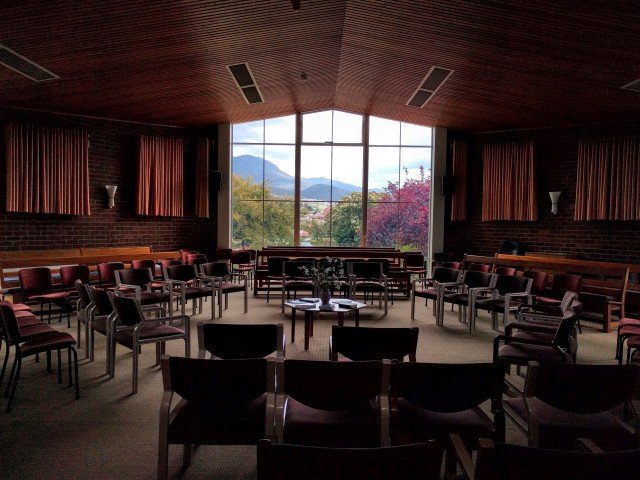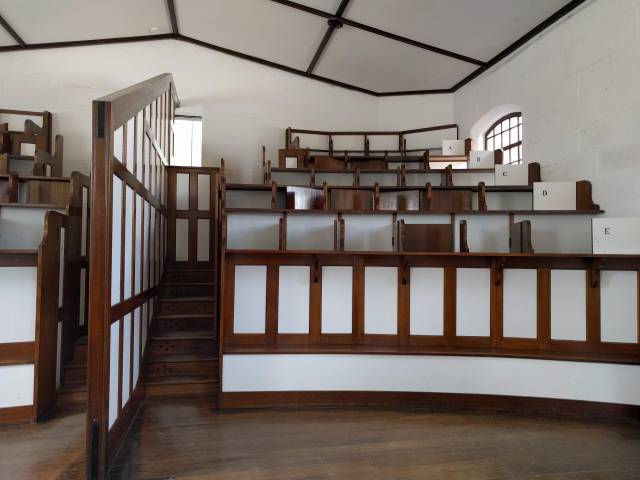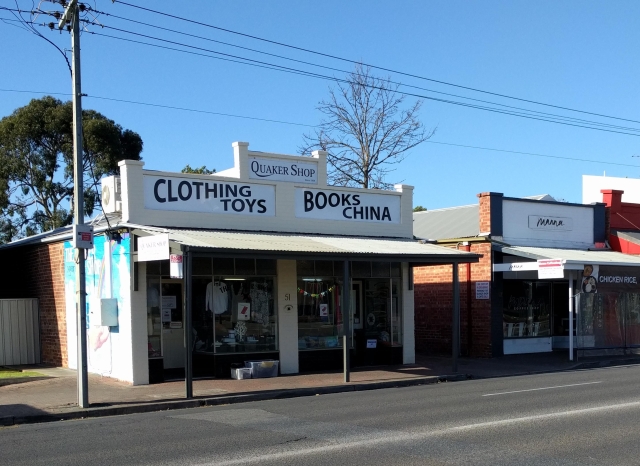
Hobart Friends Meeting House
In our month in Australia we had an interesting range of interactions with Quakers and Quakerism.
In Hobart we arranged to visit the Friends School, an institution begun by Quakers in 1887. It is the largest Quaker School in the world, with approximately 1200 students, both day and (at the high-school level) boarding.
Based on our experience of Carolina Friends School, which has deliberately stayed relatively small, our question was how a large school that follows the International Baccalaureate curriculum could maintain its Quaker character.
To help answer that question, our host for the visit, Emily Searle-Chapman, arranged for us to attend 3 different “gatherings” (times of worship) with different age groups, as well as take a quick tour of the primary school facilities. (Each class in the school has a gathering at least once a week in the Hobart Quaker Meeting House. This building, which sits on the grounds of the school, has a lovely hexagonal worship room with floor to ceiling windows offering a stunning view of Mt. Wellington hovering over the town of Hobart, see above.)
We worshiped with 12, 8, and 15 year olds. They all wear uniforms, but it was clear from some of the missing ties, untucked shirts, and various-length skirts that a “dress code” is not a defining issue in the school. For each gathering, Emily introduced visitors, read a brief poem, and asked the students to reflect on it. As often happens at Carolina Friends School, the younger students were more vocal than the older students! We were struck by the invitation during the worship with the teens to either speak a message or draw it on a whiteboard. Apparently this practice started about a year ago and the students do use the whiteboard (although not the day we were there). We felt very much at home at each of these gatherings, and even played a short piano duet for the oldest group, at Emily’s invitation.
Between the gatherings, we toured the primary school and engaged in wonderful conversation in the primary school staff room. We discovered the teachers face some of the same challenges as teachers at CFS – including how to explain Quakerism and Quaker worship to parents who are not Quakers (which includes most of the parents!). They are experimenting with how and when to include parents in the weekly Gatherings, and also have a lending library specifically for parents. We were also very impressed with their special needs room, where students who have different learning styles come not only for remedial help, but “to learn how their brains work and how to work with that,” as the director put it.
We left Hobart Friends School with a sense that Quaker values are alive and well at the school, and that care is being taken to ensure that this unique aspect of the school does not fall by the wayside.
Our second run-in with Quakerism was much more disturbing. Port Arthur, near Hobart, is where convicts were imprisoned when England used Australia as a dumping ground for criminals. Built on a remote peninsula, Port Arthur grew into quite a bustling village, using convict labor to make boats, farm, fell timber, etc. The prison closed in the late 1860s and the town dwindled, but it is now a National Park and various buildings are being reconstructed.
One of these is the “Silent Prison”, where chronically misbehaving convicts were placed in solitary confinement. This is where Quakerism raised its head again, as the tour guide explained that Quakers in England believed that you couldn’t reform a prisoner through physical punishment, but that if you gave prisoners time for silent reflection then transformation might occur, and that this idea was behind the construction of the Silent Prison.
Unfortunately, the guide didn’t make any distinction between the original idea (with its seed of truth) and the actual practices that took place at the prison. These included isolating the prisoners not only from each other, but dehumanizing them by calling them by numbers instead of names, requiring them to cover their faces when outside of their cells, allowing no speech, and punishing rule infractions by putting prisoners in special cells that allowed no light or sound to enter. They even went so far as to build a chapel where the prisoners had to attend the service in individual “cells” that all faced toward the preacher and prevented them from seeing their neighbors.

This is what the preacher would see in the “silent prison” chapel: the prisoners would see ONLY the preacher.
We wish there was a way to counteract the association of Quakers with this sort of punishment.
Thankfully, we also experienced the vibrancy of Quakers in the Quaker Meeting in Hobart, where we worshiped with them on Sunday. We also facilitated a conversation after worship using the metaphor of “rooms of the meeting house” to offer a playful way of exploring how different people are attracted and nurtured by different parts (or “rooms”) of Quaker faith and practice.
We also had the delight of reconnecting and staying with James and Flora Fox, whom we got to know in Auckland when they spent 10 days at the Friends Center, and also with Ronis Chapman and Michael Searle (whose daughter Emily had shown us the school, and whom we had met in Wellington!).

Ronis and Michael, Mike and Marsha, and Flora and James — reconnecting in Hobart.
From Hobart we went on to Adelaide where we joined with about 16 other Quakers from the South Australia and Northern Territories Regional Meeting for their annual weekend retreat. (This “regional meeting” covers about a third of Australia – all the way from Adelaide on the south coast to Darwin on the north coast.)
From Hobart we went on to Adelaide where we joined with about 16 other Quakers from the South Australia and Northern Territories Regional Meeting for their annual weekend retreat. (This “regional meeting” covers about a third of Australia – all the way from Adelaide on the south coast to Darwin on the north coast.)
The Adelaide Meeting House is near the center of town, tucked under the shadow of the Anglican Cathedral. It has a fascinating history. It was built in England and shipped in flat sections to Australia in 1840 and erected in an area that was on the edge of town. When the cathedral was built next to it 20+ years later, one small corner of the cathedral extended onto the Quakers’ property, so to this day the cathedral still pays a “peppercorn rent” of a few cents each year!


We had delightful conversations with Friends from around Adelaide both as part of the formal Regional Meeting program and over various meals. We also had the opportunity to visit the Quaker Store in Adelaide. This thrift shop is owned by the Adelaide Meeting and run by volunteers and raises thousands of dollars for charities. It is clearly one way that Quakers are “noticed” in Adelaide, since most of the volunteers are not connected with the Meeting!

We were graciously hosted during our time in Adelaide by Peter and Julie Webb. They are both musicians and we enjoyed singing with Peter’s choir, and “trading” music: Mike and I played piano duets and performed Schubert’s “Winterreise”, while Peter played the didgeridoo (of which he is an avid collector) (video clip here). Peter also allowed me (Marsha) to try (and fail) to make the didgeridoo speak. In addition to music, Julie and Peter were also very patient with us and our desire to see a koala. It took us three walks along the river, but eventually we were successful!
From Adelaide we flew to Alice Springs, in the center of Australia, and had a wonderful chat over juice (too hot for tea!) with Diana Campbell, a Quaker who is part of the South Australia and Northern Territories Regional Meeting but doesn’t often get to their meetings, given that Alice Springs is 952 miles from Adelaide.
Our final fling with Australian Quakers was a sumptuous dinner at the home of Elizabeth Kwan, a Quaker in Darwin who also worships with the Uniting Church. She is heavily involved in the Alternatives to Violence (AVP) program in Darwin, and invited over several other friends who share her concern for peace work and prison reform – including another Quaker whom we had met in Hobart who is currently splitting her time between Darwin and Hobart for family reasons. Once again, we realized how small the Quaker world is!


